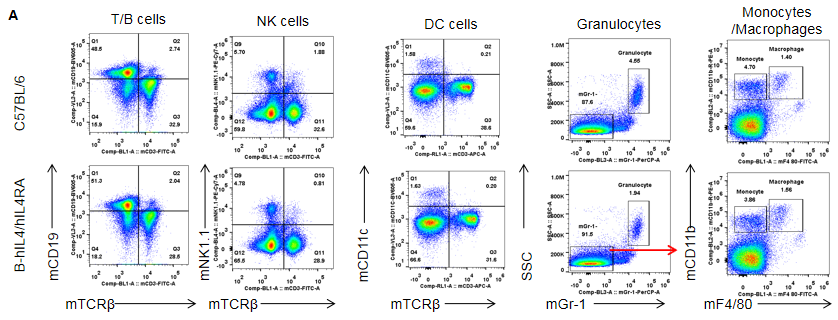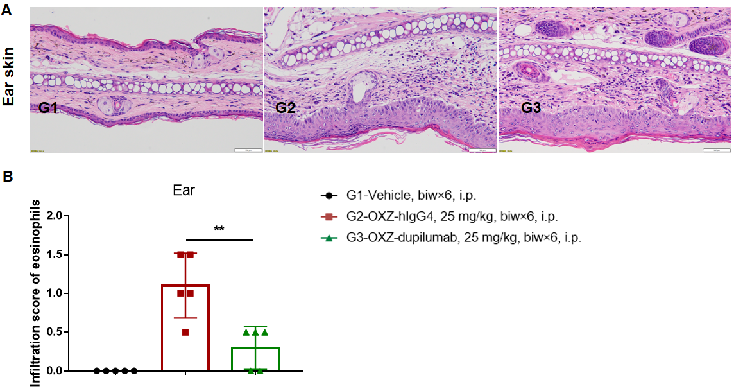|
Strain Name
|
C57BL/6-Il4tm2(IL4)Il4ratm1(IL4RA)/Bcgen
|
Common Name
|
B-hIL4/hIL4RA mice
|
|
Background
|
C57BL/6
|
Catalog number
|
120551
|
Related Gene
|
BCGF-1, BCGF1, BSF-1, BSF1, IL-4
CD124, IL-4RAA, IL4R
|
NCBI Gene ID
|
16189,16190
|
mRNA expression analysis

Strain specific analysis of IL4 and IL4RA gene expression in WT and B-hIL4/hIL4RA mice by RT-PCR. Mouse Il4 and Il4ra mRNA was detectable in splenocytes of wild-type (+/+) but not in homozygous B-hIL4/hIL4R mice (H/H) mice. Human IL4 and IL4RA mRNA was detectable only in homozygous B-hIL4/hIL4R mice but not in wild-type mice.
Protein expression analysis

Strain specific IL4 expression analysis in homozygous B-hIL4/hIL4RA mice by ELISA.
Serum were collected from WT and homozygous B-hIL4/hIL4RA (H/H) mice stimulated with anti-CD3ε in vivo, and analyzed by ELISA with species-specific IL4 ELISA kit. Mouse Il4 was detectable in WT mice. Human IL4 was exclusively detectable in homozygous B-hIL4/hIL4RA mice but not WT mice.
Protein expression analysis

Strain specific IL4RA expression analysis in homozygous B-hIL4/hIL4RA mice by flow cytometry. Splenocytes were collected from WT and homozygous B-hIL4/hIL4RA (H/H) mice, and analyzed by flow cytometry with species-specific anti-IL4RA antibody. Mouse Il4ra was detectable in WT mice. Human IL4RA was exclusively detectable in homozygous B-hIL4/hIL4RA mice but not WT mice.
Analysis of spleen leukocytes cell subpopulations in B-hIL4/hIL4RA mice


Analysis of spleen leukocyte subpopulations by FACS
Splenocytes were isolated from female C57BL/6 and B-hIL4/hIL4RA mice (n=3, 10-week-old). Flow cytometry analysis of the splenocytes was performed to assess leukocyte subpopulations. A. Representative FACS plots. Single live cells were gated for CD45 population and used for further analysis as indicated here. B. Results of FACS analysis. Percent of T, B, NK, Monocyte, DC and macrophage cells in homozygous B-hIL4/hIL4RA mice were similar to those in the C57BL/6 mice, demonstrating that introduction of hIL4 and hIL4RA in place of its mouse counterpart does not change the overall development, differentiation or distribution of these cell types in spleen.
Analysis of spleen T cell subpopulations in B-hIL4/hIL4RA mice
Analysis of spleen T cell subpopulations by FACS
Splenocytes were isolated from female C57BL/6 and B-hIL4/hIL4RA mice (n=3, 10-week-old). Flow cytometry analysis of the splenocytes was performed to assess leukocyte subpopulations. A. Representative FACS plots. Single live CD45+ T cells were gated for CD3+ T cell population and used for further analysis as indicated here. B. Results of FACS analysis. Percent of CD8, CD4, and Treg cells in homozygous B-hIL4/hIL4RA mice were similar to those in the C57BL/6 mice, demonstrating that introduction of hIL4 and hIL4RA in place of its mouse counterpart does not change the overall development, differentiation or distribution of these T cell sub types in spleen. Values are expressed as mean ± SEM.
Analysis of Lymph node leukocyte subpopulations in B-hIL4/hIL4RA mice
Analysis of subpopulation of leukocytes in lymph node by FACS
Lymph node were isolated from female C57BL/6 and B-hIL4/hIL4RA mice (n=3, 10-week-old). Flow cytometry analysis of the lymph node was performed to assess leukocyte subpopulations. A. Representative FACS plots. Single live CD45+ T cells were used for further analysis as indicated here. B. Results of FACS analysis. Percent of T, B, and NK cells in homozygous B-hIL4/hIL4RA mice were similar to those in the C57BL/6 mice, demonstrating that introduction of hIL4 and hIL4RA in place of its mouse counterpart does not change the overall development, differentiation or distribution of these cell types in lymph node. Values are expressed as mean ± SEM.
Analysis of lymph node T cell subpopulations in B-hIL4/hIL4RA mice

Analysis of subpopulation of T cells in lymph node by FACS
Lymph node were isolated from female C57BL/6 and B-hIL4/hIL4RA mice (n=3, 10-week-old). Flow cytometry analysis of the lymph node was performed to assess leukocyte subpopulations. A. Representative FACS plots. Single live CD45+ T cells were used for further analysis as indicated here. B. Results of FACS analysis. Percent of CD8, CD4, and Treg cells in homozygous B-hIL4/hIL4RA mice were similar to those in the C57BL/6 mice, demonstrating that introduction of hIL4 and hIL4RA in place of its mouse counterpart does not change the overall development, differentiation or distribution of these T cell subtypes in lymph node. Values are expressed as mean ± SEM.
Dupilumab significantly inhibited the secretion of IgE induced by hIL4 in B-hIL4/hIL4RA mice
(A) Splenic B cells from C57BL/6 and B-hIL4/hIL4RA mice were cultured with LPS alone or together with 50ng/mL mIL-4/hIL-4. Culture supplements were harvested on day 6 for quantification of IgE by ELISA.(B) Splenic B cells from B-hIL4/hIL4RA mice were incubated with increasing doses of dupilumab (in house) for half of an hour before adding LPS and hIL-4 (50 ng/mL). Culture supernatant was harvested on day 6 for quantification of IgE by ELISA. The result show that B cells from B-hIL4/hIL4RA mice responded well to LPS and IL-4 with IgE production, as similar to C57BL/6 mice. Dupilumab (in house) could effectively block the expression of IgE.
Dupilumab significantly inhibited the activation of B cells induced by hIL4 in B-hIL4/hIL4RA mice
Analysis of activity of B cells in spleen by FACS
Splenocytes were isolated from B-hIL4/hIL4RA mice and incubated with varying concentrations of IgG4 or dupilumab for half an hour. Adding human IL4 (50 pM) for 72 hours and analyzing the activity of B cells. The dupilumab group showed an effect to block B cell activation in B-hIL4/IL4RA mice and showed a dose-dependent effect; the control hIgG4 did not show an effect on block B cell activation.
In vivo efficacy of anti-human IL4RA antibody with asthma mouse model
The number of BALF immune cells in mouse asthma model


Analysis of immune cells in BALF by FACS. BALF immune cells were isolated from B-hIL4/hIL4RA mice (n=4 or n=5). The number and proportion of eosinophils were analyzed by flow cytometry under the treatment of PBS/dupilumab (in house). After treatment of dupilumab (in house), the number of CD45+ cells and eosinophils were much lower than the positive control in homozygous B-hIL4/hIL4RA mice.
OVA specific and total IgE production in serum and BALF of mouse asthma model

IgE production in serum of mouse asthma model. Serum was collected at the study endpoint. IgE levels responded to OVA-specific antibody and total IgE levels were analyzed. The results show that the levels of IgE in mice treated with dupilumab (in house) is much lower than that in untreated mice.
H&E staining in asthma-like model in B-hIL4/hIL4RA mice

H&E staining of asthma-like model in B-hIL4/hIL4RA mice. Lung tissues were collected at the study endpoint. H&E staining results showed that the lung tissues from B-hIL4/hIL4RA mice exposed to PBS aerosols did not show any inflammation. OVA exposure resulted in a significant increase in peribronchial and perivascular inflammation in B-hIL4/hIL4RA mice. A significant reduction in eosinophils infiltration was observed in mice treated with dupilumab (in house).
Asthma model introduction
Establishment of asthma mouse model- HDM-induced acute asthma model
Experimental animals:5-6 weeks old, female
Modeling reagent:50 μg HDM in 50 μl PBS (intranasally, i.n.)
Modeling paradigm:
Efficacy assessment of anti-human IL4RA antibody in mouse asthma model induced with HDM

The asthma model was induced in B-hIL4/hIL4RA mice using HDM. (A)The number of CD45+ cells in BALF. (B)The number of eosinophils in BALF. (C)The proportion of eosinophils to CD45+ cells. The results showed that after sensitization and challenge with HDM, the leukocyte infiltration of mice in G2 model group was significantly increased compared with G1 control group, and their eosinophil content was significantly increased, suggesting that the model was successfully established. After administration of 25 mg/kg dupilumab (in house), the numbers of CD45 + cells and eosinophils were significantly lower compared with the G2 model group.
Efficacy assessment of anti-human IL4RA antibody in mouse asthma model induced with HDM

Detection of IgE levels in serum of asthmatic mouse model. Serum was taken at the end of the experiment and total IgE levels were measured using ELISA in serum. The results showed that the levels of total IgE in G2 model group were significantly increased compared with G1 control group, suggesting successful modeling. Total IgE levels were significantly lower after administration of dupilumab (in house) drug compared with the G2 modeling group.
Experimental schedule for Induction of AD-like skin lesions and in vivo efficacy of anti-human IL4RA antibody
Experimental schedule for Induction of AD-like skin lesions and in vivo efficacy of anti-human IL4R antibody. OXZ was applied to dorsal and ear skin of mice on day 0, and then challenge to the same site of skin ten times from days 7 to 26. Anti-human IL4RA antibody dupilumab (in house) was administered by intraperitoneal injection twice a week on days 6 to 23. Serum, ear and dorsal skin were collected at the endpoint on day 26. AD: atopic dermatitis; OXZ: oxazolone.
In vivo efficacy of anti-human IL4RA antibody-Experiment 1 with AD model
Efficacy of anti-human IL4RA antibody in B-hIL4/hIL4RA mice. Mice in each group were treated with different dose of dupilumab produced in house. Doses are shown in legend. (A) Body weight changes during treatment. (B) Statistical analysis of ear thickness in each group. Epidermis of ear began to desquamate from day 18. So the ear thickness was decreased from day 18 as shown in figure. (C) Total IgE levels in serum. Total IgE levels were measured by ELISA on day 26. Ear thickness and concentrations of total serum IgE were negative related with the doses of antibody. (n = 5).
H&E staining of ear skin in atopic dermatitis model of B-hIL4/IL4RA mice

Effects of anti-human IL4RA antibody on inflammatory infiltration in ear skin of the AD mouse model. (A) Hematoxylin and eosin (H&E) staining. (B) Score of eosinophils infiltrated in ear epidermal skin (n=5). Infiltration scores of eosinophils in ear skin were negatively related to the doses of antibody, demonstrating that the B-hIL4/hIL4RA mice provide a powerful preclinical model for in vivo evaluation of anti-human IL4RA antibodies. Infiltration score of eosinophils: 1=slight; 2=mild; 3=moderate; 4=severe. AD: Atopic dermatitis; ND: Not detectable.
In vivo efficacy of anti-human IL4RA antibody-Experiment 2 with AD model
Efficacy of anti-human IL4RA antibody in B-hIL4/hIL4RA mice. Mice in each group were treated with dupilumab produced in house. Doses are shown in legend. (A) Body weight changes during treatment. (B) Statistical analysis of ear thickness in each group. Epidermis of ear began to desquamate from day 18. So the ear thickness was decreased from day 18 as shown in figure. (C) Total IgE levels in serum. Total IgE levels were measured by ELISA on day 26. Ear thickness and concentrations of total serum IgE were negative related with the doses of antibody. (n = 5).
H&E staining of ear skin in atopic dermatitis model of B-hIL4/IL4RA mice
Effects of anti-human IL4RA antibody on inflammatory infiltration in ear skin of the AD mouse model. (A) Hematoxylin and eosin (H&E) staining. (B) Score of eosinophils infiltrated in ear epidermal skin (n=5). Infiltration scores of eosinophils in ear skin were significantly reduced after administration of the antibodies, demonstrating that the B-hIL4/hIL4RA mice provide a powerful preclinical model for in vivo evaluation of anti-human IL4RA antibodies. Infiltration score of eosinophils: 1=slight; 2=mild; 3=moderate; 4=severe. AD: Atopic dermatitis; ND: Not detectable.



































 京公网安备: 11011502005564号
京公网安备: 11011502005564号